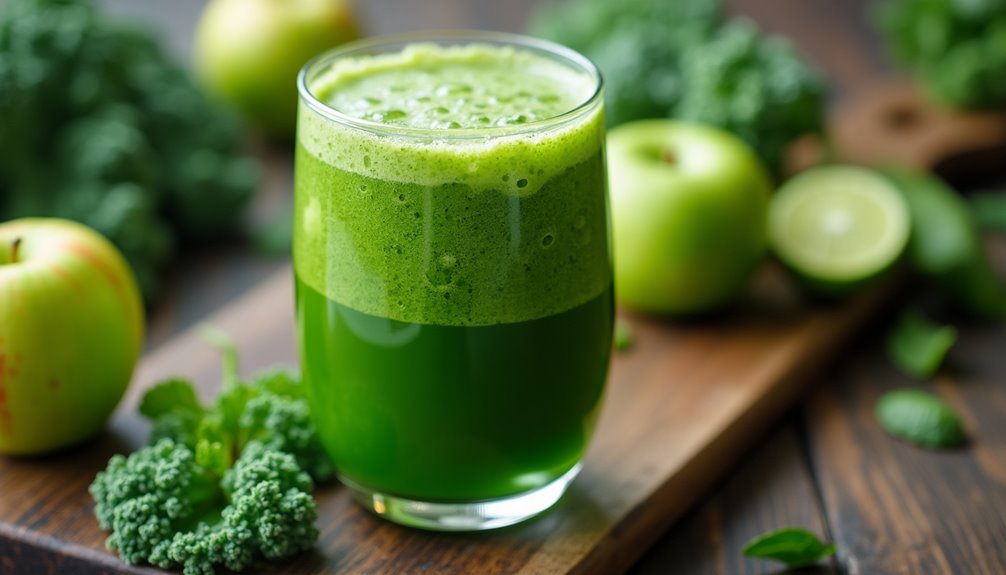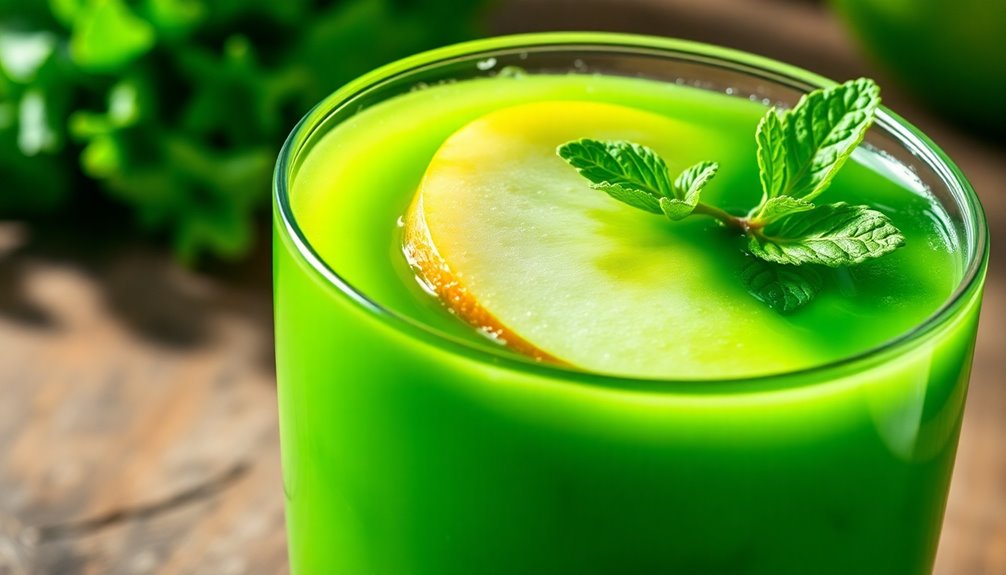A typical serving of green juice packs around 126 calories, mostly from carbohydrates. You'll find that about 89% of the calorie content comes from carbs, giving you a quick energy boost. There's also a small amount of fat and protein, making it a nutrient-rich choice. With nearly 96% of your Daily Value for vitamin C, it's not just low in calories—it's packed with benefits. Stick with us to uncover more about its nutritional profile.
Key Takeaways
- A typical serving of green juice contains approximately 126 calories.
- About 89% of the calories in green juice come from carbohydrates.
- Green juice has a small amount of fat, accounting for around 5% of its calories.
- Protein makes up roughly 6% of the macronutrient content in green juice.
- The drink provides a quick energy boost, making it ideal for post-workout consumption.

Have you ever wondered how many calories are packed into that refreshing glass of green juice? You might be surprised to learn that a typical serving of green juice contains approximately 126 calories. The majority of these calories come from carbohydrates, which make up about 89% of the drink’s macronutrient content. This means that when you’re sipping on a green juice, you’re primarily consuming carbohydrates, which can provide a quick energy boost, especially if you’re looking for something revitalizing post-workout or as a mid-day pick-me-up. Additionally, it’s important to note that while the calorie content of green juice may seem moderate, the nutritional benefits it offers can be significant. Many green juices are rich in vitamins and minerals, thanks to their base ingredients like leafy greens and fruits, which can support overall health. However, if you’re mindful of your caloric intake, it’s good practice to balance your consumption of green juice with other nutrient-dense foods.
Now, let's dive into the breakdown of those nutrients. In a single serving, you also get a small amount of fat—around 5%—and a bit of protein, which accounts for roughly 6%. While the percentages of fat and protein are low, they still contribute to the overall nutritional profile of your green juice. This balance is essential in a well-rounded diet, even if green juice leans heavily towards carbohydrates.
One of the most impressive aspects of green juice is its vitamin content. A serving can provide you with a staggering 96% of the Daily Value for vitamin C. That's right! Just when you thought you were indulging in a tasty beverage, you're actually loading your body with a key nutrient that supports immune function and skin health. This high vitamin C content makes green juice an excellent choice if you're trying to boost your nutrient intake without consuming excessive calories.
You might also want to pay attention to the sugars in your green juice. A typical serving can contain up to 22 grams of sugars, which includes naturally occurring sugars derived from the fruits and vegetables used in the blend. While this might seem high, it's important to remember that these sugars come from whole foods, providing not just sweetness but also additional nutrients. Unlike added sugars found in many processed foods, these natural sugars come with beneficial vitamins and minerals.
Moreover, green juice offers a good source of dietary fiber, contributing about 16% of the Daily Value in just one serving. Fiber is essential for digestive health, helping to keep you feeling full and satisfied. This means that a glass of green juice can be a great addition to your diet, as it provides not only hydration and vitamins but also promotes healthy digestion.
Frequently Asked Questions
Is Green Juice High in Calories?
You might be surprised to find that green juice isn't high in calories.
It typically contains between 126 and 217 calories per serving, largely from carbohydrates. While the sugars can add up, especially from fruits like apples, the overall fat content is minimal.
Instead of worrying about calories, consider focusing on the vitamins and minerals packed into each glass, which can contribute significantly to your daily nutrient intake.
Is It OK to Drink Green Juice Everyday?
Yes, it's generally okay to drink green juice every day, as it can boost your vitamin and mineral intake.
However, make sure you're balancing it with whole fruits and veggies to get enough fiber.
Keep an eye on your portion sizes and the ingredients, too, since some juices can be high in natural sugars.
Incorporating it into a well-rounded diet can support hydration and digestion without overwhelming your system.
How Many Calories Are in a 32 Oz Green Juice?
Think of a 32 oz green juice like a refreshing garden in a bottle.
When you pour it, you're looking at around 504 calories, based on an average of 126 calories per 8 oz serving.
Remember, the exact calorie count can shift depending on the ingredients you choose.
Typically, it's rich in carbohydrates, while fat content remains minimal.
Enjoy it as a nutrient-packed way to sip on essential vitamins without too many calories!
How Many Calories in a Green Detox Juice?
When you sip on a green detox juice, you're consuming around 126 calories per serving.
Most of those calories come from carbohydrates, making up about 89% of the total.
You'll also get a healthy dose of vitamins, with nearly all your daily vitamin C needs and a good portion of vitamin A.
Plus, the juice packs 22 grams of natural sugars and offers dietary fiber, giving your body a nutritious boost.
Conclusion
In conclusion, when you sip on a green juice, you're not just treating your body to essential nutrients; you're also embracing a refreshing way to stay hydrated, rejuvenate your energy, and boost your overall wellness. With its low calorie count and vibrant flavors, green juice offers a delicious choice for those seeking a healthy lifestyle. So go ahead, indulge in this nutritious delight, and enjoy the benefits it brings to your body and mind. Cheers to your health!
Cindy thoroughly researches juicing trends, techniques, and recipes to provide readers with practical advice and inspiration. Her writing style is accessible, engaging, and designed to make complex concepts easy to understand. Cindy’s dedication to promoting the advantages of juicing shines through her work, empowering readers to make positive changes in their lives through the simple act of juicing.

















